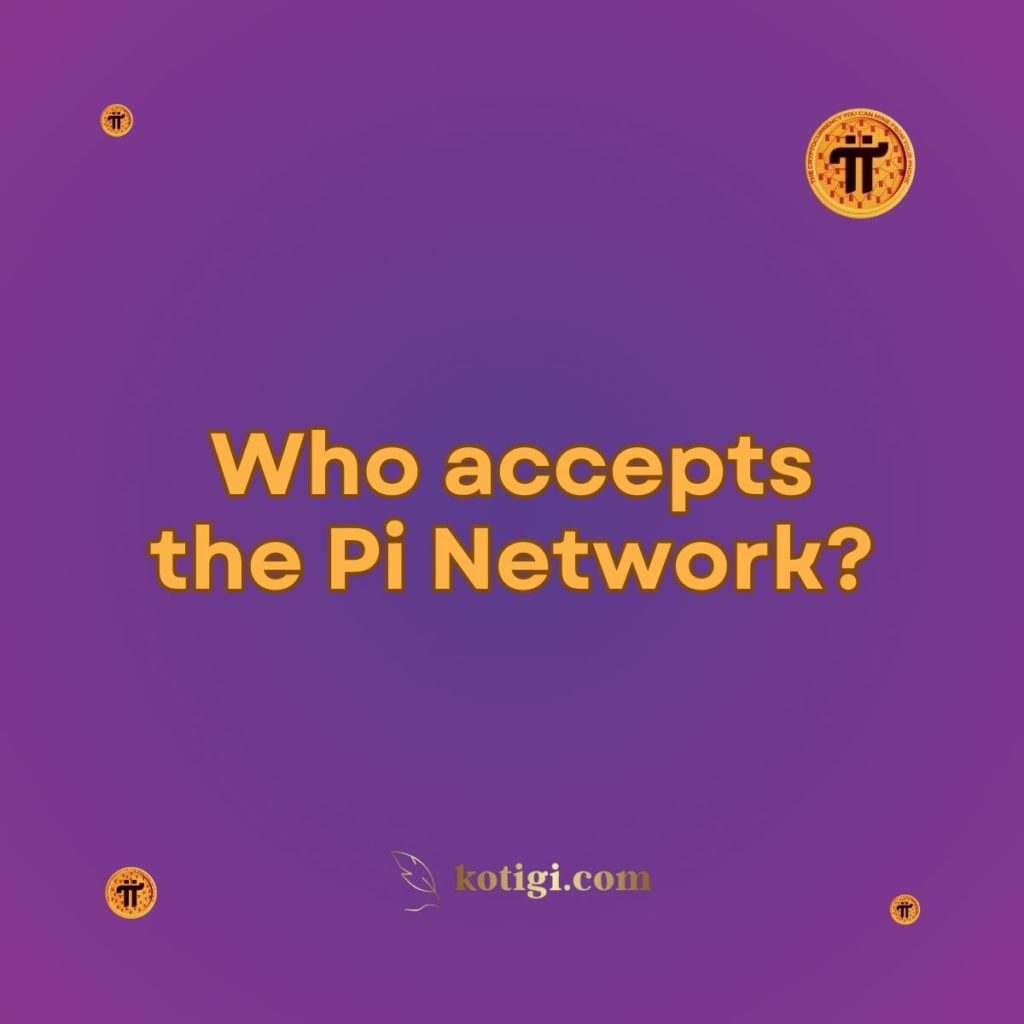
Who accepts the Pi Network?
As of now, Pi Network is not widely accepted for transactions due to its enclosed Mainnet phase. However, Pi Network is developing an ecosystem where businesses and individuals can use Pi for real-world transactions once it fully launches on the open Mainnet. Several pioneers are already experimenting with Pi payments within the Pi community through peer-to-peer (P2P) transactions and on Pi marketplaces. Read on to discover who currently accepts Pi and what the future might hold for its use as a digital currency.
Introduction
Pi Network, a revolutionary project aimed at making cryptocurrency accessible to everyone, has generated a lot of interest. While Pi coins are being mined by millions of users globally, one of the pressing questions is: Who actually accepts Pi for goods and services?
At this point, Pi Network is still in its enclosed Mainnet phase, meaning that Pi coins cannot yet be exchanged for traditional currencies or widely used for purchases in the broader market. However, there are certain platforms and initiatives within the Pi community that have begun experimenting with accepting Pi for transactions. This article will explore who currently accepts Pi, how pioneers are using Pi for peer-to-peer (P2P) exchanges, and what the future holds for Pi as a currency.
What Is the Enclosed Mainnet Phase?
Understanding Pi’s Development Phases
Pi Network is currently in its enclosed Mainnet phase, which is a critical part of its development. During this phase, Pi coins are transferred only within the Pi ecosystem, and external transactions (such as trading on public exchanges) are not allowed. This allows the Pi team to focus on building the infrastructure, implementing security features, and ensuring that all pioneers complete the KYC (Know Your Customer) process.
What Does This Mean for Acceptance?
Because of this enclosed phase, Pi cannot yet be used on a large scale or accepted by traditional businesses. Instead, Pi transactions are primarily limited to peer-to-peer (P2P) exchanges within the Pi community and Pi-related marketplaces that operate in a closed-loop system. Once Pi launches its open Mainnet, which will allow the coin to interact with external platforms and be listed on cryptocurrency exchanges, acceptance is expected to increase significantly.
Who Currently Accepts Pi?
Peer-to-Peer (P2P) Transactions
While Pi cannot yet be traded for fiat currencies, some users are already finding ways to use their mined Pi coins through P2P transactions. Pioneers within the community are voluntarily trading goods and services for Pi in a barter-like system. These transactions typically occur on social media platforms, community forums, and dedicated Pi marketplaces where users agree to exchange Pi for tangible items or services.
For example, some pioneers are offering freelance services like graphic design, writing, or tech support in exchange for Pi. Others might sell products like clothing, gadgets, or digital goods, accepting Pi as payment instead of traditional currencies.
Pi Marketplaces and Ecosystem Initiatives
There are also a few Pi-specific marketplaces and platforms that allow users to trade goods and services using Pi. These platforms are still in their early stages, but they provide a glimpse into how Pi could function as a currency in the future. Some of these marketplaces operate within the Pi ecosystem, providing users with a place to spend their mined Pi on items such as digital goods, electronics, or household products.
A notable example is PiChainMall (PCM), one of the most popular Pi-based marketplaces that allows users to buy and sell products using Pi. Sellers on PiChainMall list items, and buyers can use Pi to purchase them. However, since Pi coins cannot yet be exchanged for fiat, the value of these transactions is largely determined by the mutual agreement of the participants, based on future expectations of Pi’s value.
Local and Small-Scale Businesses
In some regions, especially in countries with strong Pi communities, small businesses are starting to experiment with accepting Pi as payment. These businesses are not officially partnered with Pi Network, but they are testing the concept by accepting Pi from local pioneers in exchange for goods or services. These businesses usually operate in niche communities where both the sellers and buyers are Pi users, and transactions occur in a local, informal setting.
However, the adoption of Pi by traditional businesses is still limited at this stage, largely due to the enclosed Mainnet phase and the uncertainty around Pi’s future value.
What Is the Future of Pi Acceptance?
The Launch of the Open Mainnet
Once Pi launches its open Mainnet, the coin will be able to interact with external networks, and it could become available on cryptocurrency exchanges. This will significantly increase Pi’s utility and the likelihood of businesses accepting it as a form of payment. The open Mainnet will also allow users to exchange Pi for other cryptocurrencies or fiat, giving Pi a market-determined value that could make it more attractive for merchants.
Potential Partnerships with Businesses
Pi Network’s development team has stated that they are working on creating an ecosystem where businesses can easily integrate Pi into their payment systems. Once Pi is tradable on the open market, it is possible that partnerships with businesses and e-commerce platforms will emerge, allowing users to spend Pi in more traditional ways, such as online shopping or retail stores.
Pi’s success as a currency will largely depend on its market value, ease of use, and scalability. If Pi can establish itself as a stable and widely accepted cryptocurrency, it could become an attractive option for businesses looking to accept digital currencies.
Pi Utility for Decentralized Applications (dApps)
Another potential area for Pi acceptance lies in the development of decentralized applications (dApps) on the Pi blockchain. These dApps could enable users to spend Pi on various services within the Pi ecosystem, such as gaming, entertainment, or online services. If Pi Network’s blockchain proves to be robust and scalable, dApps could drive significant adoption and create new use cases for Pi coins.
Benefits of Using Pi for Transactions
Accessibility and Ease of Use
One of the main advantages of Pi is its accessibility. Pi can be mined on mobile devices without the need for expensive hardware or significant energy consumption, making it available to a wide audience. This accessibility could make Pi an appealing option for businesses looking to reach customers in developing regions or areas with limited access to traditional banking services.
Low Transaction Fees
Compared to traditional payment systems, Pi transactions within its ecosystem may have lower fees and faster processing times. Once the open Mainnet is live, the Pi Network could potentially offer a cost-effective alternative for businesses looking to reduce transaction costs, especially for international payments.
Challenges for Pi Acceptance
Market Volatility and Uncertainty
Like all cryptocurrencies, Pi will likely face challenges related to market volatility. Once Pi becomes tradable on exchanges, its price could fluctuate significantly, making it difficult for businesses to adopt it as a stable form of payment. Additionally, Pi’s current value is uncertain, as it is not yet listed on any exchanges, leaving many users questioning whether their mined Pi will be worth anything once it becomes tradable.
Regulatory Concerns
For Pi to be widely accepted, it must comply with global regulations surrounding cryptocurrency usage. Businesses may be hesitant to accept Pi until its legal standing is clarified and it becomes fully compliant with financial regulations in various countries. Pi Network has emphasized its commitment to regulatory compliance, including implementing KYC verification for all users, but the broader regulatory landscape for cryptocurrencies remains uncertain in many regions.
Conclusion
Currently, Pi is not widely accepted outside of its enclosed ecosystem, as the project is still in its developmental stages. However, pioneers are actively experimenting with Pi transactions through P2P exchanges and Pi-related marketplaces like PiChainMall. The true potential of Pi as a widely accepted currency will likely be realized once the project launches its open Mainnet, allowing for broader adoption and tradability on cryptocurrency exchanges.
While the acceptance of Pi is limited at present, the network’s large user base and the vision of its development team suggest that Pi could play a significant role in the future of digital payments. For now, pioneers can engage in small-scale Pi transactions within the community and stay tuned for updates on the open Mainnet launch, which will mark a major turning point for Pi’s acceptance.
Key Takeaways:
- Pi is not yet widely accepted for traditional transactions due to its enclosed Mainnet phase.
- Pioneers are engaging in P2P transactions and using Pi in closed-loop marketplaces like PiChainMall.
- Small businesses in some regions are experimenting with accepting Pi for goods and services.
- Broader acceptance of Pi is expected once the open Mainnet launches and Pi becomes tradable.
- Pi’s future acceptance depends on its market value, regulatory compliance, and successful integration into business ecosystems.





